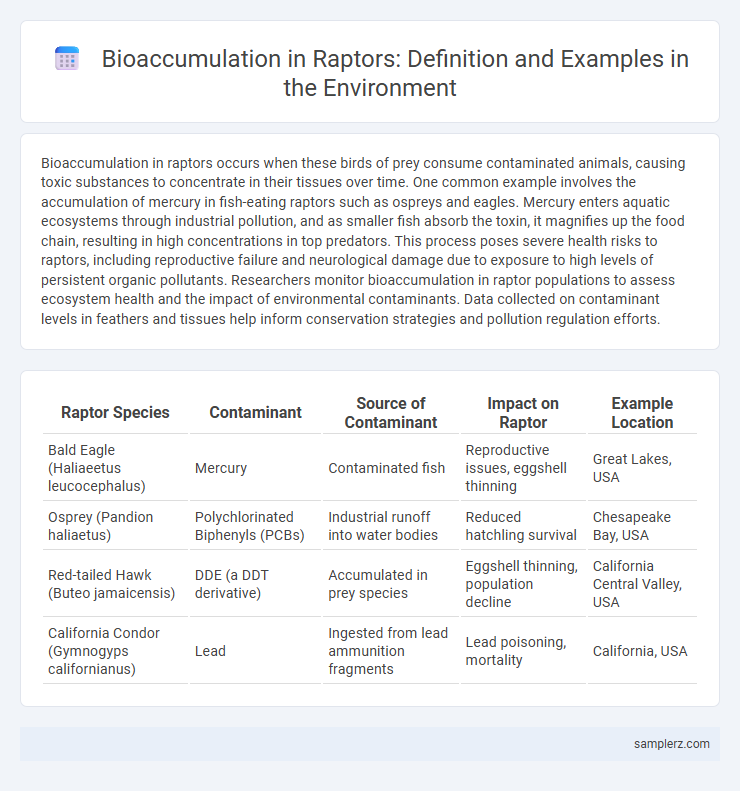Bioaccumulation in raptors occurs when these birds of prey consume contaminated animals, causing toxic substances to concentrate in their tissues over time. One common example involves the accumulation of mercury in fish-eating raptors such as ospreys and eagles. Mercury enters aquatic ecosystems through industrial pollution, and as smaller fish absorb the toxin, it magnifies up the food chain, resulting in high concentrations in top predators. This process poses severe health risks to raptors, including reproductive failure and neurological damage due to exposure to high levels of persistent organic pollutants. Researchers monitor bioaccumulation in raptor populations to assess ecosystem health and the impact of environmental contaminants. Data collected on contaminant levels in feathers and tissues help inform conservation strategies and pollution regulation efforts.
Table of Comparison
| Raptor Species | Contaminant | Source of Contaminant | Impact on Raptor | Example Location |
|---|---|---|---|---|
| Bald Eagle (Haliaeetus leucocephalus) | Mercury | Contaminated fish | Reproductive issues, eggshell thinning | Great Lakes, USA |
| Osprey (Pandion haliaetus) | Polychlorinated Biphenyls (PCBs) | Industrial runoff into water bodies | Reduced hatchling survival | Chesapeake Bay, USA |
| Red-tailed Hawk (Buteo jamaicensis) | DDE (a DDT derivative) | Accumulated in prey species | Eggshell thinning, population decline | California Central Valley, USA |
| California Condor (Gymnogyps californianus) | Lead | Ingested from lead ammunition fragments | Lead poisoning, mortality | California, USA |
Introduction to Bioaccumulation in Raptors
Bioaccumulation in raptors occurs when toxic substances like mercury and polychlorinated biphenyls (PCBs) accumulate in their tissues through the food chain. Raptors such as eagles and hawks ingest contaminated prey, leading to higher concentrations of toxins that impact their reproductive success and overall health. Monitoring bioaccumulation in raptors provides critical insights into ecosystem contamination and helps guide environmental protection efforts.
What is Bioaccumulation?
Bioaccumulation is the process by which toxic substances such as heavy metals or pesticides concentrate in an organism over time, often through the food chain. Raptors, like eagles and hawks, accumulate high levels of mercury and DDT because they consume contaminated prey, leading to reproductive failures and population declines. This buildup poses significant risks to their health and ecosystems, highlighting the importance of monitoring pollutant levels in top predators.
How Chemicals Enter Raptor Food Chains
Persistent organic pollutants like DDT accumulate in aquatic ecosystems, entering small fish and invertebrates that raptors prey on, such as ospreys and eagles. These chemicals concentrate progressively at each trophic level, leading to higher toxin levels in top predators through biomagnification. Ingesting contaminated prey results in bioaccumulation of harmful substances in raptors, affecting reproductive success and survival rates.
Case Study: DDT Accumulation in Peregrine Falcons
Peregrine falcons experienced significant bioaccumulation of DDT through the food chain, leading to eggshell thinning and population decline. Studies in the mid-20th century showed DDT concentrations in falcon tissues reaching harmful levels due to their predatory diet of contaminated birds. The ban on DDT in the 1970s contributed to gradual recovery of peregrine falcon populations and reduction in bioaccumulated pesticide residues.
Mercury Contamination in Bald Eagles
Mercury contamination in Bald Eagles exemplifies bioaccumulation, as these raptors ingest contaminated fish, causing mercury levels to rise in their tissues over time. High mercury concentrations disrupt Bald Eagles' neurological functions and reproductive success, leading to decreased population growth. Monitoring mercury bioaccumulation in Bald Eagles serves as a critical indicator of aquatic ecosystem health and pollutant transfer through food webs.
The Impact of PCBs on Osprey Populations
Polychlorinated biphenyls (PCBs) bioaccumulate in osprey through contaminated fish consumption, leading to reproductive failure and eggshell thinning. Studies show PCB concentrations reaching up to 100 ppm in osprey tissues, significantly reducing hatch rates and chick survival. Persistent PCB contamination in aquatic ecosystems continues to threaten osprey population recovery and ecosystem health.
Bioaccumulation and Eggshell Thinning
Bioaccumulation of DDT in raptors, such as the peregrine falcon and bald eagle, leads to eggshell thinning, causing reduced reproductive success and population declines. The pesticide DDT metabolizes into DDE, which interferes with calcium carbonate deposition in eggshells, making them fragile and prone to breakage. Monitoring DDT residues in raptor tissues has been critical for understanding ecosystem contamination and implementing wildlife conservation measures.
Trophic Levels and Chemical Magnification
In raptors such as eagles and hawks, bioaccumulation occurs as harmful chemicals like mercury and DDT concentrate progressively at higher trophic levels, leading to toxic magnification in top predators. These chemicals enter the food chain at lower trophic levels, such as aquatic invertebrates or small fish, and their concentrations magnify exponentially through each predator-prey interaction. This chemical magnification disrupts reproduction and survival rates in raptor populations, illustrating the critical environmental impact of bioaccumulation across food webs.
Consequences for Raptor Health and Survival
Bioaccumulation of toxic substances such as mercury and polychlorinated biphenyls (PCBs) in raptors leads to weakened immune systems, reproductive failure, and impaired neurological functions. These contaminants concentrate in tissues over time, causing reduced survival rates and population declines among top predators like eagles and hawks. Monitoring pollutant levels in raptor populations provides critical data for ecosystem health assessments and conservation strategies.
Strategies for Reducing Bioaccumulation in Raptors
Raptors experience bioaccumulation primarily through the ingestion of contaminated prey containing persistent organic pollutants like mercury and PCBs. Strategies for reducing bioaccumulation in raptors include habitat restoration to decrease exposure to contaminated sites, enforcing stricter regulations on pollutant emissions, and monitoring prey species to manage toxin levels effectively. Implementing these measures helps protect raptor populations by reducing the concentration of harmful substances entering their food chain.

example of bioaccumulation in raptor Infographic
 samplerz.com
samplerz.com